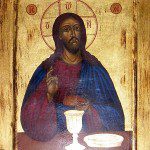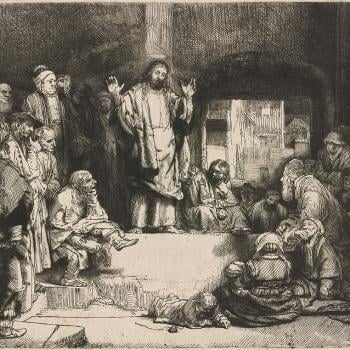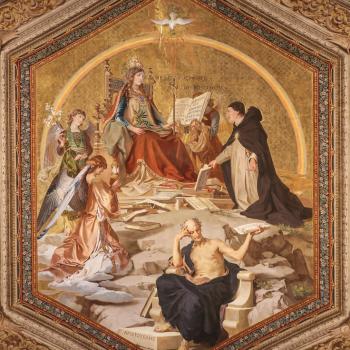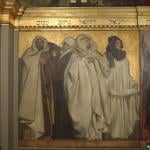![Isaiah worshipping the Virgin Mary and Child Jesus, Early 13th century. Saint Catherine's Monastery, Sinai (Egypt) / K. Weitzmann: "Die Ikone"See page for author [Public domain], via Wikimedia Commons](https://wp-media.patheos.com/blogs/sites/637/2016/06/Isajah__Mary_Icon_Sinai_13th_century-232x300.jpg)
Veneration of Mary and the saints comes out of the recognition of the good which God has done in and with them. To show them honor and respect does not violate the first commandment, but rather, helps fulfill it. If veneration of anyone other than God is in violation of the first commandment then God would not have told us to honor anyone other than himself, such as our father and mother, but that is exactly what he did: “Honor your father and your mother, that your days may be long in the land which the LORD your God gives you” (Ex. 20:12 RSV). If we followed our parents and placed them and their wishes above God then there would be a problem. While we can show people who do indeed honor their parents in this illicit fashion, such abuse does not prove that all such honoring of our parents is to be rejected. Similarly, if we ever would find those honoring Mary and saints with adoration which is due to God alone, this does not mean all such veneration of the saints is adoration and to be rejected.
Praising the good which is found in the world, honoring the good done by others, and loving it, is not the problem, rather, it is doing so in an inordinate fashion. The first commandment is about justice, about establishing right order, and that right order gives God adoration above all others, but then makes room for and expects us to honor others relative to the good established in and through them. Thus, St. Bonaventure explained:
And it should be noted that the whole of the Law commands nothing but justice. For the Law is the rule of justice. Moreover, justice is that which orders the human person to God and to his neighbor. And so there is a twofold justice; one by which we are ordered to God, and the other by which we are ordered to our neighbor.[1]
We are to honor God, but for this to properly be done, we must also honor the good which flows from God relative to the value of the good involved. James, after all, tells us all such good comes from God: “Every good endowment and every perfect gift is from above, coming down from the Father of lights with whom there is no variation or shadow due to change” (James 1:17 RSV). Because of how we are ordered in the world, we are also to honor and respect the good which is in proximity to us. Therefore, we are to honor our father and mother, because it is just, and in doing so, we honor God so long as our father and mother do not make demands contrary to God’s justice.
It is justice that brings us to honor all that is good, so long as we do so in right measure.[2] The more someone has cooperated with grace, the more they deserve to be honored, because such grace renders them holy. The greater the holiness, the greater the good, the more deserving that good is to be praised. This is why the one who has become full of grace, Mary, deserves the most honor and respect of all.[3]
What God forbids by the first commandment is the taking of some relative good as an absolute. For this is what creates a false god, and with it an image or idol which needs to be rejected. For what is suggested by that image runs contrary to the truth. This is why we are to deny anything which we put in front of us which takes the place of God in our lives, even if they are good and worthy of being honored. When we have understood their relative goodness and what that means in relation to the absolute of God, we are able to find their proper place in our lives and so honor them.[4] And so the object of our adoration might indeed be someone who is worthy of veneration, someone who has done a great amount of good which we should respect, but if we transpose that good to the absolute and so turn some relative good into the absolute good, we produce for ourselves a false image, and it is that, this false image which is to be denied as a fiction whose falsehood must be obliterated – without actually destroying the relative good in the process.[5]
Clearly, the question of images and their use in spiritual devotion requires more than this to affirm their proper place in Christian worship. The text of Exodus seems to be exhaustive when it says we are not to make an image of anything in heaven and on earth. But when we explore the Torah further, we find that this command was not exhaustive but had limits. God commanded the Ark of the Covenant to be constructed with two cherubim on its top (cf. Ex. 25:18). Moses used a serpent staff (cf. Num. 21:8) as a healing device, which Jesus said represented him on the cross (cf. John 3:14), showing us how the bronze serpent was, in itself, an image of Jesus established by God. Because the incarnation had not yet occurred, the serpent staff was a vague image and was later misunderstood, becoming used as an idol which had to be destroyed.[6] “If God formerly condescended to be symbolized by a serpent in order to heal those who were bitten, how could it not be pleasing to Him and appropriate to set up the image of the bodily form which has been His since He became man?”[7] Only after the incarnation, when God the Son, the perfect image of the invisible God (Col. 1:15), came before us, did the use of images become perfected. God has created the means to represent him in images by taking on a body, a body which, like all bodies, always contains its own image. And through that representation God has opened up not only an image for himself, where we depict him according to the image he presented to us in his body, but for those who are joined in with him, his co-workers, the saints. For their images demonstrate the work of God found in creation. Thanks to the incarnation, holiness is possible in the flesh. Without such recognition of the saints, of the ability to represent them in images, our understanding of the perfection of God’s work by Jesus would suffer. We would end up questioning the effectiveness of grace in the material world, and with it, we would be led to believe that only formless spirits are able to be filled with grace, and so we would end up having a gnostic view of the flesh which rejects its place in the kingdom of heaven.
More to Come
[1] St. Bonaventure, Collations on the Ten Commandments. trans. Paul J. Spaeth (St. Bonaventure, New York: The Franciscan Institute, 1995), 26.
[2] Those who do not honor the saints, out of willful ignorance or malice, purposefully reject the right honor due to the goodness of God they have participated in, and so, in the end rejects giving God his due as much as it rejects giving them the proper honor they have due to them for the good they have achieved.
[3] “More honorable than the Cherubim, beyond compare, more glorious than the Seraphim,” is the way the Divine Liturgy of St John Chrysostom expresses this fact.
[4] Once we have God, and keep ourselves centered upon God, all things come to us in their proper order and form, and we can and will honor them according to that level of honor they are due as a way to honor and love God.
[5] Falsehood is the overlaying something which has no real existence over that which does, putting non-being over real being, non-existence over existence. Since God is the source of all existence, falsehood has no participation in God and it is why it needs to be rejected and removed, allowing the truth which was tarnished to be brought back out into the open.
[6] The serpent eventually was destroyed because it was later seen as a God in and of itself (cf. 2Ki 18:4). This shows how both how an image can be good and use righteously by some, and abused by others.
[7] St. Theodore the Studite On the Holy Icons. trans. Catharine P. Roth (Crestwood, NY: St Vladimir’s Seminary Press, 1981; second printing 1993), 25.
Stay in touch! Like A Little Bit of Nothing on Facebook:
A Little Bit of Nothing










